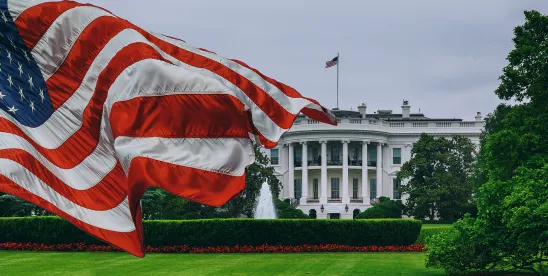I. Introduction
On July 4, 2025, President Trump signed the One Big Beautiful Bill Act (the “Act”) into law.[1] The Act is similar to the Senate Finance Committee’s draft legislative text (the “SFC Bill”) (released on June 16, 2025), with several modifications and omissions. The Act’s key differences from the SFC Bill and the prior House version of the legislation (passed on May 22, 2025) (the “House Bill”) are noted below.[2]
The Act:
- Increases the qualified small business stock (“QSBS”) exclusion cap for stock acquired after July 4, 2025 to the greater of (i) $15 million (rather than $10 million) or (ii) 10x the investor’s stock basis; introduces a phase-in structure for gain exclusion based on holding period; and expands the scope of stock qualifying as QSBS by increasing the gross asset threshold to $75 million (rather than $50 million);
- Includes a first-time 100% expensing provision for “qualified production property” (“QPP”), which includes certain commercial real property that generally depreciates over a 39-year useful life;
- Clarifies that the disguised sale of partnership interests rule under section 707(a)(2) is self-executing and does not require regulations; [3]
- Modifies the private university endowment excise tax from a fixed 1.4% rate to a tiered system with the highest rate of 8% and applies the tax only to universities with at least 3,000 (rather than 500) tuition-paying students;
- Does not include section 899, the “revenge tax” introduced by the House on residents of countries that impose “unfair foreign taxes” on U.S. persons;[4]
- Does not include the new tax on litigation financing that was originally introduced by Senator Thom Tillis (R-NC);
- Does not include any restriction of pass-through entity tax (“PTET”) deductions;
- Does not include the increased 23% section 199A deduction proposed by the House (the section 199A deduction remains at 20%);
- Does not extend the section 199A deduction that currently exists for investments in real estate investment trusts (“REITs”) to business development companies (“BDCs”);
- Does not increase the private foundation net investment income tax;
- Does not limit amortization of a professional sports franchise and related intangible assets, as proposed by the House;
- Does not treat a tax-exempt organization’s income from the sale or license of its name or logo as “unrelated taxable income”, as proposed by the House; and
- Does not include any carried interest provision.
II. Summary of Key Provisions
A. International Provisions
- BEAT Made Permanent at 10.5%. Under prior law, the base-erosion and anti-abuse tax (the “BEAT”) rate under section 59A was 10% and was set to rise to 12.5% in 2026. The Act increases the BEAT rate from 10% to 10.5% for tax years beginning in 2026.
- GILTI & FDII.
- GILTI.
- The Act renames global intangible low-taxed income (“GILTI”) as “net CFC tested income” (“NCTI”) and eliminates the net deemed tangible income return (“NDTIR”) from the calculation of NCTI (which means that the NCTI tax is imposed on the first dollar of NCTI).[5]
- The deduction under section 250 is decreased from 50% to 40%, which increases the effective tax rate on NCTI from 10.5% to 12.6% (or 14%, taking into account the NCTI foreign tax credit discussed further below).
- The Act provides a taxpayer-favorable change to the expense allocation rules for purposes of the foreign tax credit limitation – only expenses directly allocable to CFC income, as well as the section 250 deduction, must be allocated to the GILTI basket; U.S. expenses (such as interest and R&D) are now allocated to U.S. source income.
- The Act reduces the 20% foreign tax credit “haircut” for NCTI taxes from 20% to 10% beginning December 31, 2025; thus, 90% of foreign taxes paid on NCTI can be claimed as a credit against U.S. taxes (as compared to 80% before the Act). As a result of this increased limitation, NCTI must be subject to a 14% effective tax rate for residual U.S. tax on NCTI to be fully eliminated.
- FDII.
- The Act also renames foreign-derived intangible income (“FDII”) as “foreign derived deduction eligible income” (“FDDEI”).
- The FDDEI deduction is reduced from 37.5% to 33.34%, which increases the effective tax rate on FDDEII from 13.125% to 14%. These changes apply to tax years beginning after December 31, 2025.
- Income and gain from certain sales or dispositions of intangibles (including section 367(d)(4) assets) as well as certain depreciable or amortizable assets, made after June 16, 2025, are excluded from the FDDEI base. However, unlike in the SFC Bill, income from licensing intellectual property abroad qualifies for the FDII deduction.
- The Act changes the expense allocation provisions so that deduction eligible income is reduced by expenses and deductions (excluding interest expense and research and experimental expenditures) that are properly allocable to the gross income.
- The Act also eliminates the NDTIR from the FDDEI calculation, which means that a larger portion of FDEI becomes eligible for the deduction; this change applies for tax years beginning December 31, 2025.
- GILTI.
- CFCs.
- Downward Stock Attribution Rule. Effective for tax years beginning after December 31, 2025, the Act favorably reinstates section 958(b)(4), which (prior to the Tax Cuts and Jobs Act (the “TCJA”)) did not attribute prohibits the use of downward stock attribution from a foreign person downward to a U.S. person to determine whether a shareholder is a “U.S. shareholder” and a foreign corporation is a CFC. However, downward attribution is preserved in certain cases under =new section 951B (discussed further below).
- New Inclusions for Foreign-Controlled U.S. Shareholders. The Act establishes new section 951B, which subjects “foreign-controlled U.S. shareholders” of “foreign-controlled CFCs” to modified CFC inclusion rules. A “foreign-controlled U.S. shareholder” is a U.S. person that owns over 50% of a “foreign-controlled CFC”. For purposes of this 50% threshold, section 958(b)(4) is disregarded, and downward stock attribution applies. A “foreign-controlled” CFC is a CFC that would become a CFC due to the application of section 951B. Under section 951B, foreign-controlled U.S. shareholders are required to report Subpart F and NTCI inclusions from foreign-controlled CFCs.
- CFC Look-Through Rule. The CFC look-through rule under section 954(c)(6) is made permanent. As a result, related party payments (such as dividends, interest and royalties) between CFCs are not treated as Subpart F income if the payments relate to income that is not Subpart F income or income effectively connected to a U.S. trade or business in the hands of the related CFC making the payment.
- Repeal of the One-Month Deferral Election for CFC Tax Year. The Act eliminates the election under former section 898(c)(2) that allowed certain CFCs to elect to use a tax year that begins one month earlier than its majority U.S. owner’s tax year. This repeal is effective for CFC tax years beginning after November 30, 2025.
- Repeal of the “Last Day” Rule. The Act eliminates the rule that allowed U.S. shareholders to avoid including Subpart F and GILTI income unless the U.S. shareholder owns stock in the CFC on the last day of the CFC’s tax year. U.S. shareholders are required to include their share of Subpart F and GILTI income for any year during which a foreign corporation was a CFC, and the U.S. person owned stock (directly or indirectly under section 958(a)). This is effective for tax years of foreign corporations beginning after December 31, 2025.
B. Business Provisions
- 163(j) deductions. Business interest deductions continue to be limited to 30% of “adjusted taxable income” (“ATI”) (plus business and floor plan financing interest), but the definition of ATI is again more favorably calculated based on EBITDA (as it was from 2022 to 2024), rather than EBIT. This definition will apply for all taxable years beginning after December 31, 2024. In addition, Subpart F income, GILTI inclusions, gross-up amounts for indirect foreign tax credits under section 78 and certain other income is excluded from the calculation of ATI, effective for tax years beginning after December 31, 2025. Finally, for taxable years beginning after December 31, 2025, the Act requires capitalized interest to be treated as business interest that is subject to the section 163(j) limitation, unless it is required to be capitalized under sections 263(g) or 263A(f).
- Section 199A. The Act makes permanent the 20% deduction for qualified business income (“QBI”) under section 199A, which would have sunset at the end of tax year 2025. The income threshold for phasing in the deduction has been increased from $50,000 to $75,000 (for single filers) and from $100,000 to $150,000 (for married taxpayers filing jointly). As stated above, the Act does not expand the section 199A deduction to interest-related dividends paid by BDCs, which had been proposed by the House.
- Extension of Excess Business Loss Limitation. The limitation on excess business losses for noncorporate taxpayers is made permanent.
- Section 707(a)(2) – Disguised Sale of Partnership Interests. There had been uncertainty whether section 707(a)(2), which governs disguised sales of partnership interests, was self-executing in the absence of regulations. The Act clarifies that no final regulations are needed to make section 707(a)(2) applicable to disguised sales of partnership interests.
- Qualified Small Business Stock. The section 1202 per issuer cap for excluding gain from qualified small business stock (“QSBS”) has been increased to the greater of (i) $15 million (adjusted for inflation) or (ii) 10x the investor’s stock basis (rather than the greater of (i) $10 million or (ii) 10x the investor’s stock basis) for stock acquired after July 4, 2025. In addition, for taxable years beginning after July 4, 2025, a phase-in structure for gain exclusion is based on holding period so that (i) QSBS held for at least 3 years is eligible for a 50% gain exclusion; (ii) QSBS held for at least 4 years is eligible for a 75% gain exclusion; and (iii) QSBS held for at least 5 years is eligible for 100% gain exclusion. Excludable gain that is not excluded by reason of the phase-in is subject to a 28% capital gains rate (rather than the standard 20% capital gains rate), with any remaining gain eligible for the 20% capital gains rate. Finally, the Act favorably increases the gross asset limit from $50 million to $75 million, indexed for inflation.
- Bonus Depreciation.
- The Act makes permanent the 100% first-year bonus depreciation deduction under section 168(k) for “qualified property” acquired and placed in service after January 19, 2025. “Qualified property” generally includes tangible personal property with a useful life of 20 years or less (such as equipment and machinery).
- In addition, the Act introduces a first-time 100% expensing provision for “qualified production property” (“QPP”). “QPP” includes certain commercial real property (which generally depreciates over a 39-year useful life) that begins its original use with the taxpayer, but “QPP” does not include leased property. To qualify for 100% expensing, the QPP must also (i) be used as an “integral part” of a “qualified production activity”, such as the manufacturing, production and refining of certain personal property in the United States; (ii) have begun being constructed between January 20, 2025 and December 31, 2028; and (iii) be placed in service by December 31, 2030.
- Domestic Research or Experimental Expenditures. Expensing (i.e., current deductions) for domestic research and experimental (R&E) costs in connection with the taxpayer’s traded or business is made permanent in taxable years beginning after December 31, 2024.
- Opportunity Zones. The Act makes several changes to the Qualified Opportunity Zone (“QOZ”) program, which was enacted by the TCJA. The Act extends and makes the QOZ program permanent (it would have expired at the end of 2026). The Act retains the TCJA’s full basis step up benefit for investments held for at least 10 years. Beginning July 1, 2026, state governors will be able to designate new census tracts for the OZ program; the designations will be effective on January 1, 2027. New QOZs may be designated every 10 years thereafter. Deferred gain will generally be includible in income five years after a taxpayer’s investment into a qualified opportunity fund (absent an earlier inclusion event) rather than on a specified date under the TCJA.
- The Act imposes stricter requirements than the TCJA for a census tract to be eligible for designation as a QOZ. A census tract is eligible for QOZ designation only if it is in a “low-income community.” A census tract will qualify as a low-income community if (i) the median family income in the tract does not exceed 70% (as compared to 80% under the TCJA) of the median family income in the state or metropolitan area, as applicable or (ii) the tract has a 20% or greater poverty rate, so long as the medium family income in the tract does not exceed 125% of the median family income in the state or metropolitan area. The Act also repeals the “contiguous tract” exception that permitted state governors to designate higher-income tracts as QOZs if they were contiguous to a qualifying tract and had a median family income less than 125% of the adjacent tract.
- The Act introduces significant changes relating to rural areas. The Act also establishes the qualified rural opportunity funds (“QROFs”), which must invest at least 90% in rural tracts. These QROFs offer investors substantial benefits. First, investors in QROFs are eligible for a 30% (rather than 10% for non-rural tracts) basis step up after 5 years. Second, the “substantial improvement” requirement for property in rural tracts is reduced so that only 50% (rather than 100%) of the property’s original basis (other than with respect to land) must be invested to improve the property within the required time period.
- Charitable Donation Limitation. Under the Act, non-itemizer individuals benefit from an above-the-line deduction of $1,000 (for single filers) and $2,000 (for married taxpayers filing jointly), and individuals making charitable contributions to qualified charities made in cash can be deducted up to 60% of adjusted gross income (“AGI”). However, itemizers are subject to a floor on charitable contribution deductions of 0.5% on the taxpayer’s contribution base for the taxable year. Further, a C corporation’s charitable contribution deductions are subject to a new 1% floor based on its taxable income; the existing 10% cap remains in place. Finally, high-income donors may only deduct up to 35% (rather than 37%, the highest marginal rate applicable to individuals) of donations. These changes are effective for tax years beginning after December 31, 2025.
- Taxable REIT Subsidiary Asset Test. Taxable REIT subsidiaries may represent 25% (the pre-TCJA limit) of the value of the REIT’s total assets (rather than 20% under current law). This change is effective for tax years beginning after December 31, 2025.
- Clean Energy Credits Scaled Back. The Act scales back the scope of clean energy tax incentives put in place under the Inflation Reduction Act. It gradually phases out certain manufacturing-related credits, shortens the timeframe for certain credits to be claimed and introduces new restrictions, such as with respect to components sourced from certain foreign countries.
C. Tax-Exempt Provisions
- Increased Excise Tax on Private University Endowments.The excise tax on large private university endowments has been changed from a flat 1.4% excise tax on net investment income to a tiered system – the larger an endowment is per student, the higher the tax rate, with the highest rate of 8% applying to schools with endowments of $2 million or more per student. In addition, the excise tax now only applies to schools with 3,000 (rather than 500) or more tuition-paying students (more than 50% of which are located in the United States). The Act also expands the definition of “net investment income” for these purposes to include certain student loan interest and certain royalties. As mentioned above, the Act did not include the prior proposals to increase the net investment income tax on private foundations.
- Tax on Excessive Employee Compensation. While the Act retains the 21% excise tax imposed on tax-exempt organizations in respect of employee compensation over $1 million, it expands the definition of “covered employees” to include any employee or former employee of the applicable organization during any taxable year beginning after December 31, 2016 (as compared to the top 5 highest paid employees under law prior to the Act). The change applies to taxable years beginning after December 31, 2025.
D. Individual Provisions
- Retains the Current Individual Tax Rates. The maximum rate of 37% for individuals is made permanent.
- Standard Deductions.The Act makes permanent the doubled standard deduction from the TCJA, which was set to expire in 2026, and it provides an additional deduction of $750 (for single filers) and $1,500 (for married taxpayers filing jointly).
- Personal Exemption Disallowed. The personal exemption is permanently disallowed, except certain senior taxpayers are temporarily permitted to take a personal exemption deduction of $6,000 from 2025 to 2028.
- Miscellaneous Itemized Deductions Disallowed. Miscellaneous itemized deductions are permanently disallowed (other than certain educator expenses).
- SALT Deduction Cap Increased. The state and local tax (“SALT”) deduction cap is temporarily increased from $10,000 to $40,000 for 2025, to $40,400 for 2026, increasing to 101% of previous year’s cap for 2027, 2028, and 2029, and reverts back to $10,000 for 2030 and later years. This temporary cap is phased out by 30% of the excess AGI above a threshold ($500,000 for 2025, but increasing each year), but not below the original $10,000 cap. For example, a single filer with $600,000 AGI would see their SALT cap reduced by $30,000 (30% of $100,000), resulting in a $10,000 cap. In tax year 2030, the SALT cap reverts to $10,000.
- Itemized Deduction Limits. Itemized deductions (which were disallowed under the TCJA) are allowed and made permanent. The Act repeals the Pease limitation, but reduces itemized deductions otherwise allowable for the taxable year by 2/37 of the lesser of: (i) the amount of itemized deductions otherwise allowed, and (ii) the amount by which the taxpayer’s taxable income (similarly adjusted) exceeds the 37% bracket threshold. This second prong effectively imposes an additional 2% tax (for a total 39% marginal rate) on the portion of income equal to the taxpayer’s itemized deductions.
- Deductions for Tips.Deductions of up to $25,000 per year are permitted for certain “cash tips” (including tips that are paid by card or under tip-sharing arrangements) for tax years 2025-2028. To qualify, the tips must be voluntarily paid by the customer and come from an occupation that “traditionally and customarily received tips”. The deduction phases out for taxpayers whose modified AGI exceeds $150,000 (for single filers) and $300,000 (for married taxpayers filing jointly). In addition, certain independent contractors who receive tips in a trade or business are also eligible for deductions if the gross income earned from that trade or business exceeds all deductions (not including the deductions for tips) taken in that trade or business in a taxable year.
- Overtime Compensation Deductions. Deductions of up to $12,500 (for single filers) and $25,000 (for married taxpayers filing jointly) per year are permitted for qualified overtime compensation for itemizers and non-itemizers for tax years 2025 through 2028. However, the deduction would be reduced for taxpayers whose modified AGI exceeds $150,000 (for single filers) and $300,000 (for married taxpayers filing jointly).
- Deductions for Car Loan Interest. Deductions (up to $10,000) of interest payments from 2025 through 2028 on car loans used to purchase new cars assembled in the United States. These deductions are allowed for itemizers and non-itemizers. The deduction phases out for taxpayers whose modified AGI exceeds $100,000 for single filers and $200,000 for married taxpayers filing jointly.
- Expansion of Employer-Provided Childcare Credits. Employer-provided childcare credits for business providing qualified childcare to employees are further expanded from 25% to 40% (and up to 50% for eligible small businesses). The maximum annual credit is also increased from $150,000 to $500,000 for employers (up to $600,000 for eligible small businesses).
- Family and Medical Leave Credits. Employer-provided family and medical leave credits are made permanent. The Act also expands the program to apply to part-time employees (i.e., those who work at least 20 hours/week) and to employees as early as 6 months into their employment. Employers may count wages or insurance premiums paid for leave mandated by state and local law, but only amounts exceeding the state and local minimums qualify for the credits.
- Adoption Tax Credits. Up to $5,000 of adoption tax credits are refundable.
- Scholarship-Granting Tax Credits. Beginning in 2027, tax credits of up to $1,700 are allowed for contributions by individuals to scholarship-granting organizations.
- Expansion of Qualified Tuition Programs. The Act expands qualified tuition programs that are exempt from U.S. federal income tax (i.e., “529 accounts”) to include expenses for students at an elementary or secondary public, private, or religious school, or a vocational school that leads to a license. The tax-free withdrawal limit is increased from $10,000 to $20,000 per year.
- Extension of Increased Alternative Minimum Tax Exemption from TCJA. The increased exemptions (same as under the TCJA) and increased exemption phase outs (increased from the TCJA’s 25% rate to 50%) from the individual alternative minimum tax are made permanent.
- Qualified Residence Interest Deduction Limitation. The $750,000 limitation on deductions for qualified residence interest is made permanent.
- Student Loan Discharged on Death or Disability Made Tax-Free Permanently. The Act makes permanentthe income exclusion for student loans discharged on account of death or disability. However, a social security number is required to claim this exclusion.
- Personal Casualty Loss Relief Further Extended. Beginning in 2026, personal casualty loss deductions are permanently restricted to federally declared disasters, but the Act also explicitly makes state-declared disasters eligible for relief.
- Qualified Bicycle Commuting Reimbursements. Reimbursements of bicycle commuting expenses are subject to U.S. federal income tax. Prior to the TCJA, the reimbursements were not taxable.
- Reimbursements for Personal Work-Related Moving Expenses. Before the TCJA, deductions were provided for certain personal moving expenses for employment purposes and gross income did not include qualified moving expense reimbursements from employers. The deductions are permanently repealed, and the reimbursements are permanently taxable.
- Child Tax Credits Made Permanent. The Act makes the child tax credit permanent and temporarily increases the maximum credit from $2,000 to $2,200. However, the Act caps the refundable portion of the credit at $1,400 (indexed for inflation).
- Creation of “Trump” Accounts. Trump accounts are tax-exempt trust accounts that can be created for U.S. citizens under age 18. The funds from the Trump accounts can be used for qualified expenses of the beneficiary such as higher education and first-time home purchases. The Bill provides a one-time $1,000 federal credit per eligible child born between 2025 and 2028, which will be deposited directly into the child’s Trump account.
[1] The actual name of the Act is “An Act to Provide for Reconciliation Pursuant to Title II of H. Con. Res. 14”.
[2] For more detail about the provisions included in the House Bill, please read our prior blog post here.
[3] All references to section are to the Internal Revenue Code.
[4] Section 899 was omitted from the Act following an agreement by the G7 countries on June 27, 2025 not to subject U.S.-parented groups to the OECD Pillar 2 undertaxed profits rule or income inclusion rule.
[5] Under law prior to the Act, the annual GILTI income generally includes the net CFC “tested income” of the U.S. shareholder of the CFC, reduced by the U.S. shareholder’s NDTIR.
Rita N. Halabi contributed to this article








 />i
/>i
